Personal aircraft. Understand and wait

The last 20 years, interesting, piloted, ultra-light aircraft of unconventional schemes appear - these are quadcopters, hexocopters, etc. They are developed as machines for transporting people or means for flying for your own pleasure. This is a search for new solutions, the application of new technologies, in other words, the natural process of the development of light aviation.
Designers seek to create a compact aircraft, providing easy access to the sky from small platforms. I would attribute to their features:
- Vertical (or shortened) takeoff and landing
- Compactness and safety for others during takeoff and landing
- Automatic control (partial or full).
Such devices are often referred to as Personal Aircraft. Strictly speaking, this is not entirely true.
')
Officially, the term Personal air vehicle was introduced by NASA in 2003 and was intended to provide a fast door-to-door transport solution to the client. Such a device, according to NASA, should have been able to drive on roads like a car and fly using small airfields or simply suitable sites.
Requirements for personal aircraft from NASA (2003).
- No more than 5 passengers
- Cruising speed 240-320 km / h
- Quiet, comfortable, reliable, high all-weather, low fuel consumption
- Available for piloting anyone with a driver's license
- Available for traveling as a car and as a plane
- Flight range of about 1,300 km
Attempts to create such a technique were long before 2003. Thus, in 1946, Robert Fulton (USA) completed the construction of the world's first flying Airphibian car, but it was not possible to bring it to mass production.
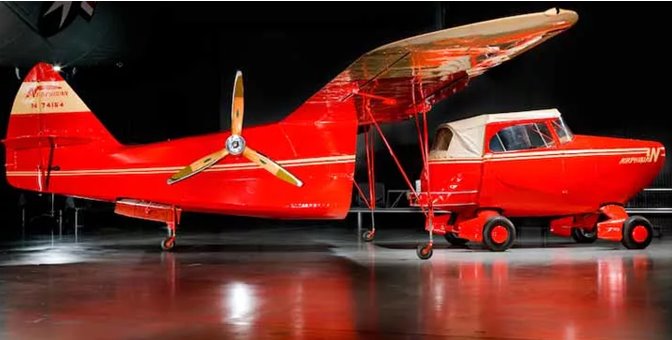
Transport problems of megacities, as well as the dream of flying from the courtyard of their own home, forced inventors to develop the direction of personal air transport.
Seventy years later, Airbus introduced the concept of an urban modular transport system.
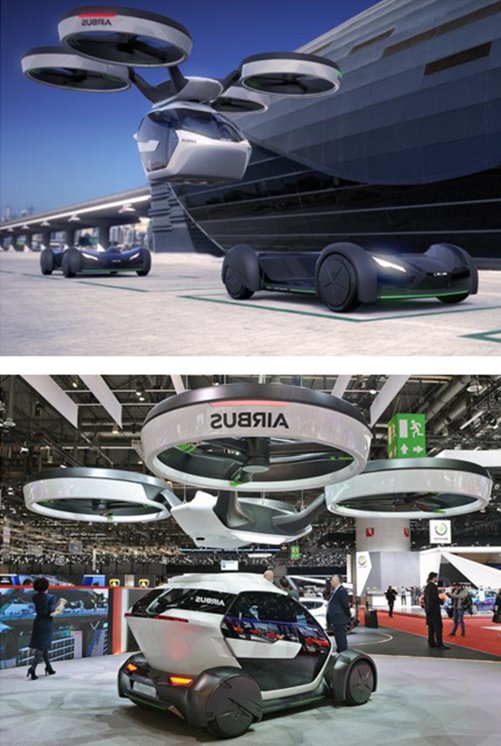
It should be noted that for seventy years the world has not seen a single serial vehicle that could be attributed to personal aircraft. If you remove the requirement of the possibility of movement on the roads as a car, light helicopters can be attributed to such devices with a stretch.
But the helicopters did not become a massive "flying taxi". First of all, it discourages the high cost of the proposal. Mass consumer can not afford it. The market needs cheaper solutions.
Creating an economical LA vertical takeoff with an autonomous control system can provide the following benefits:
- significant reduction in travel time when used as a transport system (compared to road transport);
- cheaper prices due to mass character and the absence of pilots (compared to existing air traffic);
- minimizing the number of accidents and disasters by eliminating the human factor from the control system.
Next, I want to present an overview of some really flying ALS of an unconventional circuit, released over the past 20 years, and compare their technical characteristics with the apparatus of the traditional circuit.
Let's start with the machines that I would refer to projectiles for outdoor activities.
1.1. GEN H-4
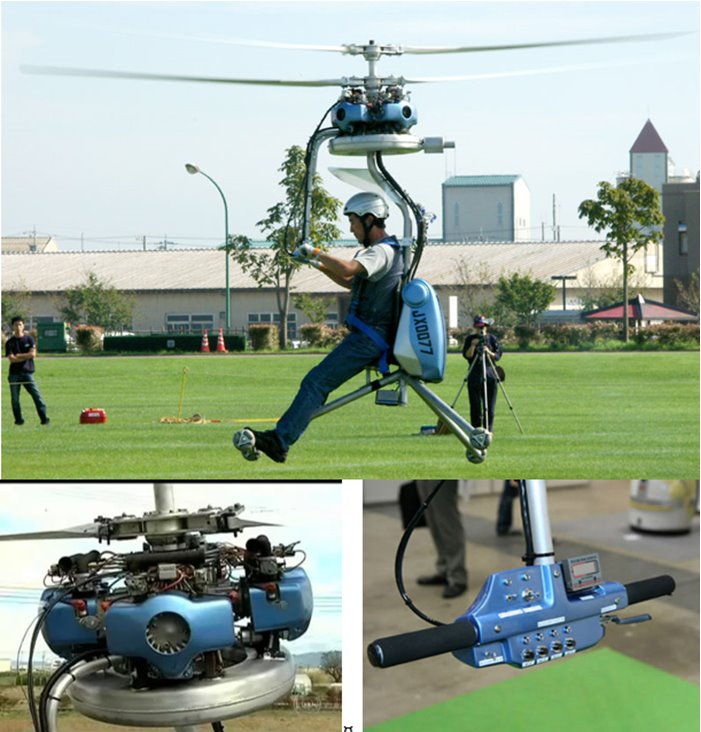
In 2000, the Japanese corporation GEN Corporation introduced an ultra-light coaxial helicopter. The power plant consists of four two-cylinder engines. The failure of the two engines allows you to make a safe landing. The pitch control (both general and cyclic) is not provided. In fact, the rotor is a fixed pitch propeller. Helicopter control is balanced.
GEN H-4 aroused great interest among potential buyers, but the car was not brought to mass production. Now on the manufacturer's website you can buy drawings for self-construction.
| Empty weight, kg | 70 |
| Maximum take-off weight, kg | 220 |
| Maximum engine power, hp | 4x10 |
| Flight time max, min | 60 |
| Maximum speed, km / h | 85 |
| Ceiling, m | 3000 |
| Cost, $ | 59 500 |
1.2. Martin Jetpack

In 2008, the New Zealand company Martin Aircraft presented, perhaps, the only, to date, personal vertical take-off device, ready for mass production. Work on the project has been going on for over 35 years.
The thrust is created by two propellers in the annular channels, rotated by an internal combustion engine. The control action is created by deflecting flaps located behind the screws.
The automatic control system provides stabilization of the device in flight.
Martin Jetpack, one of the few devices in its class, equipped with a parachute rescue system.
| Empty weight, kg | 230 |
| Maximum take-off weight, kg | 330 |
| Maximum engine power, hp | 200 |
| Flight time max, min | thirty |
| Maximum speed, km / h | 40 |
| Ceiling, m | 760 |
| Cost, $ | 150,000 |
1.3. Aerofex Aero-X
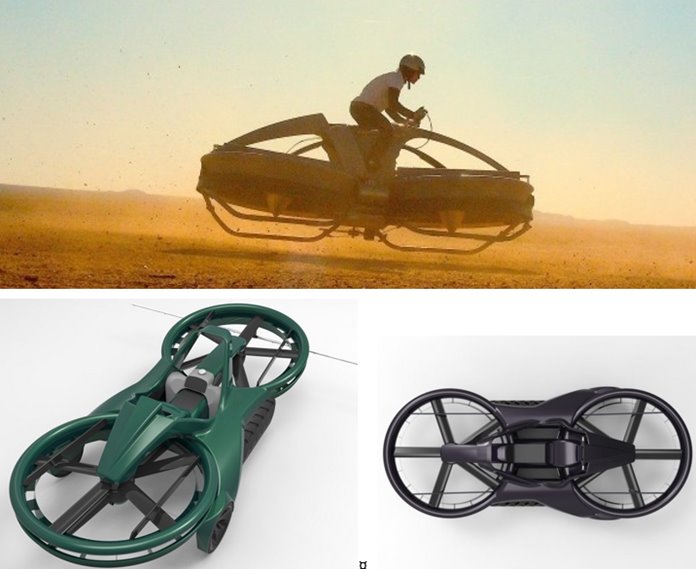
The development of a two-seater flying motorcycle is engaged in the company Aerofex . The machine is driven by two propellers of unchangeable pitch in annular channels. The power plant consists of three rotary internal combustion engines combined into one unit. For safe landing enough work of two engines of three.
The apparatus is controlled by deflecting the flow behind the propellers, for which the guide vane is used at the outlet of the annular channels.
Flight altitude is artificially limited to 3 meters. To rescue the pilot in a collision with the ground, the device is equipped with air cushions.
* The device is very similar to the VZ-8 Airgeep created by order of the US Armed Forces in 1962.
| Empty weight, kg | 356 |
| Maximum take-off weight, kg | 496 |
| Maximum engine power, hp | 240 |
| Flight time max, min | 75 |
| Maximum speed, km / h | 72 |
| Ceiling, m | - |
| Cost, $ | 85,000 |
1.4. Flyboard air
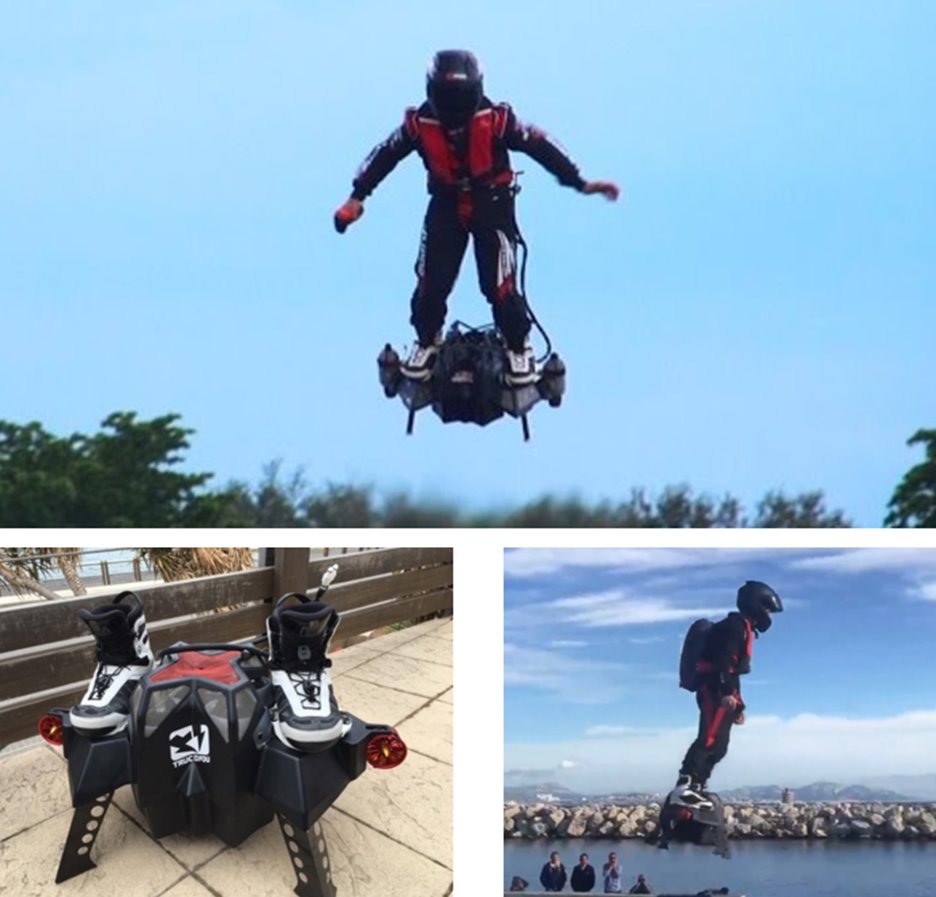
Perhaps one of the most compact individual aircraft developed Frank Zapata with his team - Flyboard Air.
Four turbojet engines create lift, for direct control of the course 2 electric impellers located on the sides of the platform are used. The kerosene fuel tank is located on the back of the pilot. Flybord Air is controlled using the handheld remote control system.
| Empty weight, kg | N / A (50) * |
| Maximum take-off weight, kg | n / a (140) * |
| Maximum engine power, hp | 4x250 = 1000 (160 kgf thrust) |
| Flight time max, min | ten |
| Maximum speed, km / h | 150 |
| Ceiling, m | 3000 |
| Cost, $ | n / a |
1.5. ArcaBoard

Flying board from Arca space corporation is equipped with 36 electric motors with fans in annular channels, powered by batteries.
The flight height of its creators wisely limited to 30 cm above the underlying surface. Automatic stabilization system should help the pilot to maintain balance. You can control the board using a smartphone or balancing your own body.
| Empty weight, kg | 82 |
| Maximum take-off weight, kg | 162 |
| Maximum engine power, hp | 7.55x36 = 272 |
| Flight time max, min | 6 |
| Maximum speed, km / h | 20 |
| Ceiling, m | - |
| Cost, $ | 14 900 |
2.1. CH-7 Kompress
(added for comparison)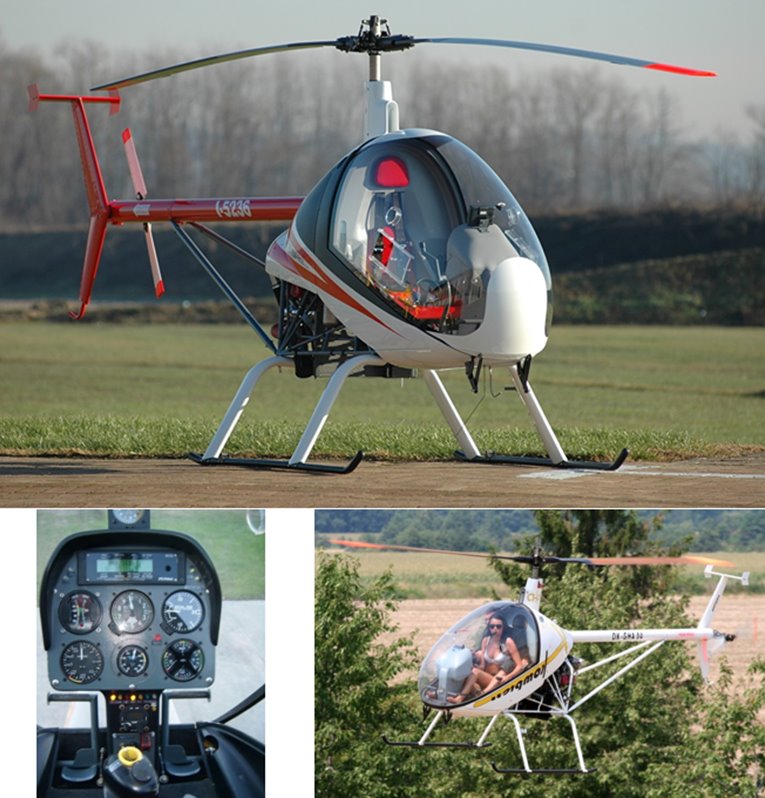
In 1996, the Italian company Helisport began mass production of the ultra-light CH-7 Kompress Charle helicopter. The dense tandem layout of the cockpit of the small midship provides good speed and range. To date, produced more than 330 machines.
It should be noted that CH-7 is one of the few commercially successful ultralight helicopters.
| Empty weight, kg | 280 |
| Maximum take-off weight, kg | 450 |
| Maximum engine power, hp | 115 |
| Flight range, km | 450 |
| Cruising speed, km / h | 100 |
| Ceiling, m | 2740 |
| Cost, $ | 115,000 |
2.2. Volocopter VC200

German aircraft manufacturers from the company E-volo developed a double multicopter equipped with 18 independent electric motors with propellers of unchangeable pitch.
The device is controlled by changing the engine speed. The control system automatically maintains the specified flight parameters, controlling the individual rotation speed of each engine.
The device is able to continue the flight in case of failure of up to six engines, the presence of a parachute rescue system provides additional safety for the crew.
| Empty weight, kg | 290 |
| Maximum take-off weight, kg | 450 |
| Maximum engine power, hp | n / a |
| Flight time max, min | 20 |
| Maximum speed, km / h | 100 |
| Ceiling, m | 2000 |
| Cost, $ | 340,000 |
2.3. Ehang 184

The Chinese company Ehang is developing a single-use electric machine, resembling an enlarged quadrocopter. According to the creators, this should be a completely autonomous aircraft (autonomous aerial vehicle), the passenger just needs to specify the point of arrival, the entire flight from take-off to landing will be provided by the onboard control system.
The aircraft moves using the thrust of four coaxial propellers of unchangeable pitch. The control is carried out by changing the speed of rotation of each of the eight independent motors.
From the point of view of mechanics, the device is interesting in its simplicity of construction, the lack of transmission and compactness.
| Empty weight, kg | 240 |
| Maximum take-off weight, kg | 340 |
| Maximum engine power, hp | 207 |
| Flight time max, min | 25 |
| Maximum speed, km / h | 60 |
| Ceiling, m | 3500 |
| Cost, $ | n / a |
Comparison
Below is a comparison of the listed devices with a helicopter. The comparison was carried out according to 3 criteria:
- range of flight;
- the relative mass of the payload (the ratio of the payload to the total take-off mass, characterizes the technical perfection of the aircraft);
- load on power (the ratio of the take-off mass to the available power of the aircraft, in other words, this value shows the mass of the apparatus per one hp of power).
Machines for outdoor activities and for the transport of people (goods) were compared separately. The comparison was made with respect to the GEN H-4 helicopter for the first table and with respect to CH-7 for the second table (for clarity, the sample parameters were taken as a conventional unit).
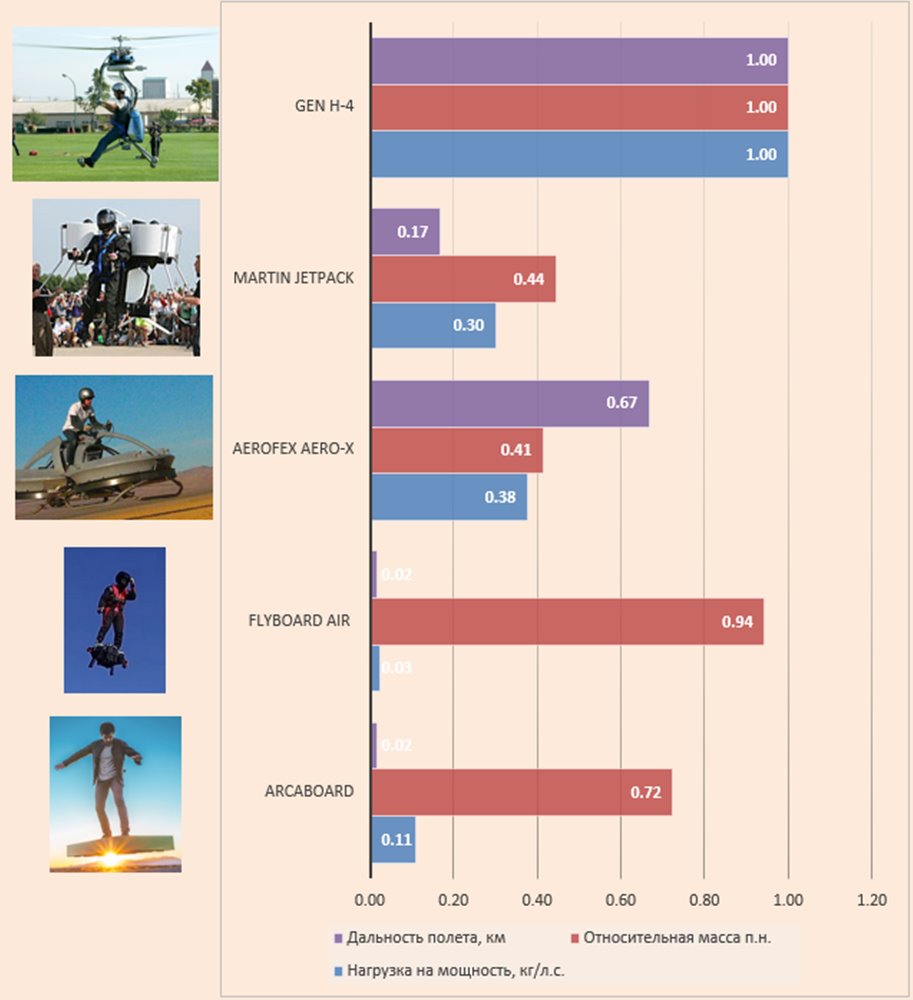

findings
1. Vertical takeoff
Vertically taking off the aircraft with fuel efficiency of the aircraft will allow to conquer the market of short-haul flights. However, the LAs are very far in flight characteristics even from a classic helicopter.
To date, there is no constructive solution that allows for vertical take-off, landing and to be more efficient than a helicopter.
slight retreat
Here is an interesting demonstration sample submitted by the agency DARPA. Vertically take-off unit XV-24A with a swivel wing and spaced electric propulsion.
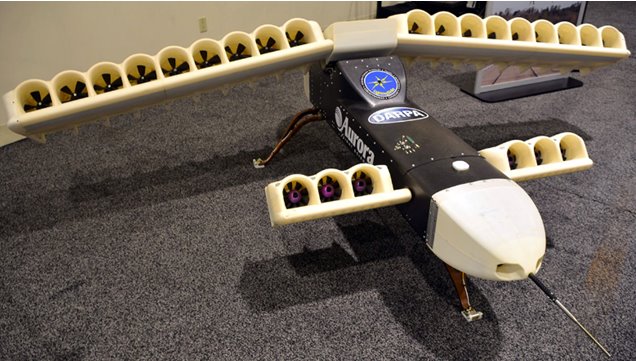
According to the developers, this machine will be more efficient than a helicopter by 25 ... 50% (meaning fuel efficiency). Impellers spaced along the length of the wing, allow you to control the flow of circulation, as well as prevent flow disruption at high angles of attack. Power is supplied from the generator on the gas turbine engine.
2. Power supply
Emerging electric motors (and controllers) with low power density and the increased power consumption of the batteries make it possible to create all-electric machines. However, according to expert estimates (the work was carried out by colleagues, was not published), with an increase in the energy intensity of batteries by 25–30 times per unit mass and a decrease in the cost of using up the battery life by 1.5–3 times, compared to today's indicators, the use of an all-electric transport aviation will become economically viable. So, while it is a question of the not near future.
For example, the Airbus E-FAN electric airplane, created in 2014, has a range of about 150 km, while its petrol classmate Cessna 150 flies to a range of 680 km.
3. Compactness
Creating a compact aircraft is commercially justified - these are small areas for takeoff and landing, a small storage area, etc. But, as can be seen from the comparative table above, replacing the rotor with several smaller diameters significantly reduces the efficiency of the propulsion system and, as a result, leads to a fall range.
4. Autonomous control
Modern autopilot in conjunction with the ground infrastructure allows you to automate all phases of flight.
It can be assumed that the control system that provides the construction of the route, the control of the aircraft, and even the selection of the landing site could be built in the near future.
The article describes the current state of affairs. Technologies have not yet matured to create a personal aircraft, in which the mass market will be interested. It may take decades. But, the presented devices may well be used for entertainment or solving special problems, if you do not take into account their cost.
Source: https://habr.com/ru/post/434586/
All Articles